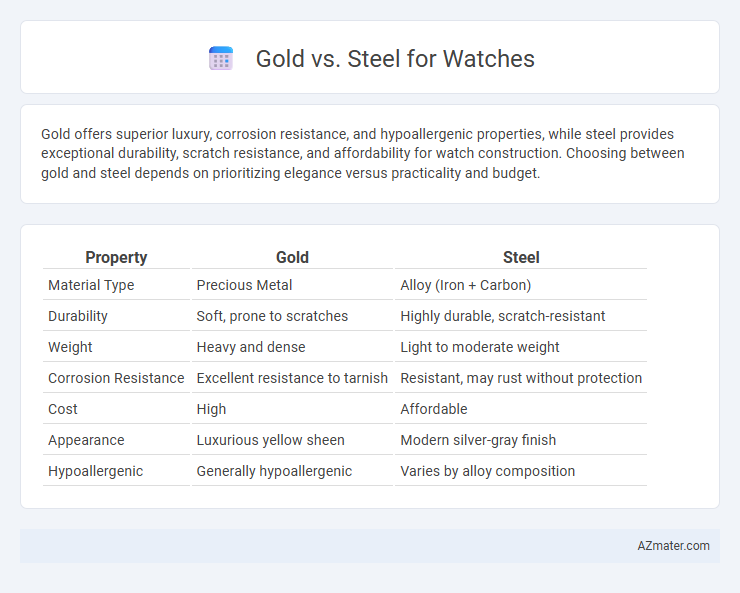Gold offers superior luxury, corrosion resistance, and hypoallergenic properties, while steel provides exceptional durability, scratch resistance, and affordability for watch construction. Choosing between gold and steel depends on prioritizing elegance versus practicality and budget.
Table of Comparison
| Property | Gold | Steel |
|---|---|---|
| Material Type | Precious Metal | Alloy (Iron + Carbon) |
| Durability | Soft, prone to scratches | Highly durable, scratch-resistant |
| Weight | Heavy and dense | Light to moderate weight |
| Corrosion Resistance | Excellent resistance to tarnish | Resistant, may rust without protection |
| Cost | High | Affordable |
| Appearance | Luxurious yellow sheen | Modern silver-gray finish |
| Hypoallergenic | Generally hypoallergenic | Varies by alloy composition |
Introduction: Gold vs Steel Watches
Gold watches offer luxurious appeal and timeless elegance, often crafted from 18k yellow, white, or rose gold, providing high value and prestige. Steel watches deliver superior durability, resistance to scratches, and a modern, versatile look favored for everyday wear and sports activities. Choosing between gold and steel depends on personal style preferences, investment considerations, and intended watch usage.
Material Composition and Characteristics
Gold watches are crafted from alloys combining pure gold with metals like copper and silver, enhancing durability while maintaining gold's distinctive luster and corrosion resistance. Steel watches typically use stainless steel alloys, primarily composed of iron, carbon, and chromium, offering high strength, scratch resistance, and hypoallergenic properties. The choice between gold and steel impacts weight, maintenance, and visual appeal, with gold providing luxury and prestige, while steel ensures robustness and everyday practicality.
Aesthetic Appeal and Design Versatility
Gold offers a luxurious and timeless aesthetic with its warm tones and natural shine, making it a popular choice for elegant and classic watches. Steel provides a modern, sleek look with its cool metallic finish and exceptional durability, allowing for versatile designs ranging from sporty to formal. The combination of gold and steel in two-tone designs enhances the visual richness, appealing to those seeking both sophistication and practicality in a watch.
Durability and Scratch Resistance
Gold watches offer luxurious aesthetics but tend to be softer and more prone to scratches compared to steel. Stainless steel is highly durable, resistant to corrosion, and maintains a scratch-resistant surface that is ideal for everyday wear. For longevity and toughness, especially in active environments, steel remains the preferred material due to its superior hardness and resilience.
Weight and Comfort on the Wrist
Gold watches are significantly heavier than steel due to gold's higher density, which can affect wrist comfort during extended wear. Steel offers a lighter and more durable option, making it preferable for everyday use and active lifestyles. The choice between gold and steel often balances luxury appeal with practical comfort on the wrist.
Price and Investment Value
Gold watches typically have a higher price point due to the precious metal's intrinsic value, rarity, and luxury status, often making them a favored choice for long-term investment. Steel watches offer a more affordable option with greater durability and resistance to scratches, making them popular for everyday wear but generally appreciating less in value over time. Investors seeking asset appreciation often prefer gold watches for their potential to retain or increase value, while steel watches prioritize functionality and cost-efficiency.
Maintenance and Longevity
Gold watches require more frequent maintenance due to their softness and susceptibility to scratches and dents, often needing regular polishing to maintain their shine. Steel watches, particularly those made from stainless steel alloys, offer superior durability and resistance to corrosion, making them lower-maintenance and longer-lasting under everyday wear. Both metals benefit from routine cleaning, but steel's robustness makes it an ideal choice for longevity and sustained aesthetic appeal.
Popular Brands and Iconic Models
Gold watches symbolize luxury and timeless elegance, often featured in iconic models like the Rolex Day-Date and Patek Philippe Nautilus, which emphasize prestige and investment value. Steel watches dominate the market with durability and versatility, exemplified by the Omega Seamaster and Audemars Piguet Royal Oak, admired for their robust performance and sport-luxury appeal. Popular brands like Rolex, Patek Philippe, Omega, and Audemars Piguet leverage both materials to cater to different lifestyles and collector preferences.
Resale Value and Market Demand
Gold watches consistently maintain higher resale value compared to steel due to the intrinsic worth of precious metals and strong demand in luxury markets. Steel watches appeal to a broader audience, offering durability and versatility, which sustains steady market demand but typically lower resale prices. Limited edition gold timepieces and those from renowned brands often command premium resale prices, reflecting scarcity and collector interest.
Choosing the Right Material for Your Lifestyle
Choosing between gold and steel for a watch depends largely on lifestyle and durability needs; gold offers luxury and prestige with softer alloy compositions, ideal for formal occasions, while steel provides superior scratch resistance and corrosion protection, perfect for active or outdoor use. Consider maintenance frequency, as gold requires more careful handling and regular polishing, whereas stainless steel demands less upkeep and withstands daily wear better. Weight and skin sensitivity also play roles--gold watches are generally heavier and hypoallergenic, whereas steel watches often feature hypoallergenic grades like 316L or 904L stainless steel, balancing comfort with toughness.

Infographic: Gold vs Steel for Watch
 azmater.com
azmater.com